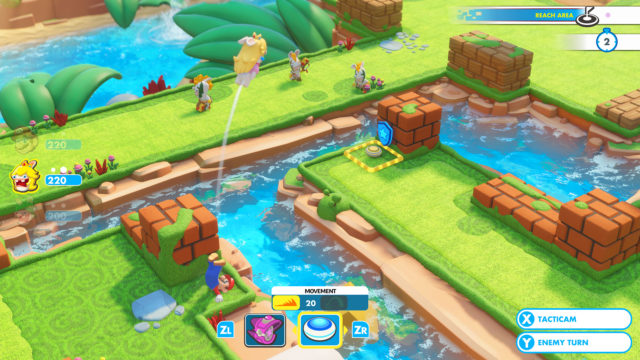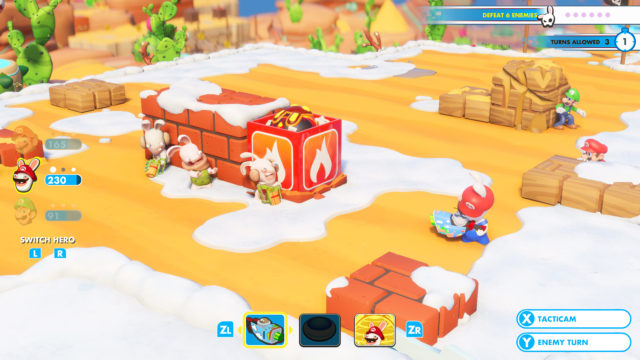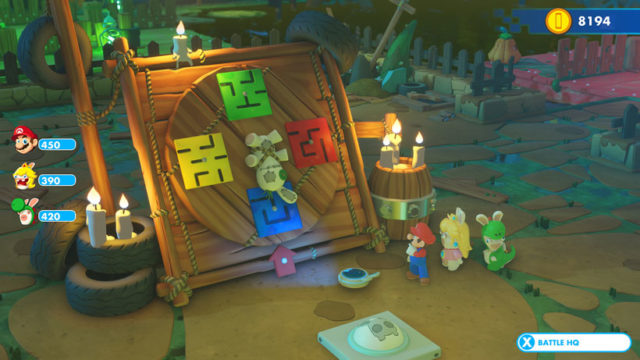A beautiful and funny marriage of the two properties; a unique and beginner friendly take on the TBS genre; campaign and extra content gives players lots to do; fantastic, orchestrated soundtrack
Fairly easy overall but with a few unexpected difficulty spikes; rewards for exploration should feature more usable content; a few minor control issues; no online play
To many, the concept of a Mario and Rabbids crossover was likely quite unexpected, even though rumors were swirling about the industry long before it was announced. The fact that the game ultimately turned out to be a trun-based strategy game, however, is downright surprising. Altogether, then, this game can be described as a strange mixture of two disparate series resulting in a genre neither series is even remotely well known for. The biggest shocker of it all is that it all comes together very well.
Developed by Ubisoft’s internal teams with the company’s proprietary engine, Mario+Rabbids: Kingdom Battle presents an adventure in which the Rabbids trademark shenanigans have led them into a collision with the Mushroom Kingdom while armed with technology that allows the user to combine any two people or items. Naturally, things go bad quickly as most of the chaotic critters find themselves fused by the device and corrupted by malevolent forces. Mario and his friends once again answer to adventure alongside a handful of friendly Rabbids, cosplaying as the land’s celebrated heroes. All of this is presented with some nicely directed cutscenes and a few more story beats for some added flavor, but it mostly just serves as a decent setup for the ridiculous concept and zany sense of humor.
The game itself is split between two alternating types of gameplay, exploration and combat. Kingdom Battle’s campaign is divided into four worlds that are mostly linear, with only the occasional bit of backtracking, and each stage is filled with hidden goodies to find. Some items are out in the open while others require a thorough examination of your surroundings or solving of extra puzzles to locate. The puzzles grow in complexity and frequency throughout the game but, for better or worse, never become all that difficult. Most of the puzzles will likely be very familiar to a seasoned gamer as they favor tried and true mechanics like flipping switches, pushing blocks, and moving platforms to open the way forward. It would have been nice to see a bit more complexity and originality in the puzzles, but what is there is solid and does a nice job of adding some variety to the game’s flow.

As the game’s title implies, the combat is the main focus of the experience. Strategy fans might see a little bit of X-COM’s DNA in the turn-based battles, but this game is not nearly as intense or punishing; don’t expect intense resource management or perma-death. Instead, Kingdom Battle is trying to present a very approachable, entry-level approach to the strategy genre without being too simplistic. The game features eight controllable characters (Mario, Luigi, Peach, Yoshi, and their Rabbid counterparts) with each featuring a unique skill tree and obvious strategic focus. Mario is an all-around solid fighter, Luigi is the designated sniper, Rabbid Peach is your medic, the real Peach is pretty much a tank, and Rabbid Mario is really good at making things explode. Instead of leveling up this cast through experience, skills and stats are improved through the use of orbs, which are acquired by completing chapters, challenge missions that open up later on, or finding them while exploring. New weapons also become available to purchase or are found throughout the game as well. While some characters share similar weapon types and everyone has a few basic moves in common, each unit feels unique and has inherent strengths and weaknesses that you’ll need to consider as you decide on which three characters to take into battle.
During combat, each character’s turn can consist of up to three actions. Moving is mostly what you’d expect but there are a few nice additions; running into an enemy initiates a dash attack for some extra damage and then selecting another of your characters allows you to jump off that character, a feature that is great for getting to higher ground or getting to some cover that otherwise would have been out of reach. Next, each character can attack with their primary or secondary weapon. Primary weapons usually focus on hitting a single foe at medium to long-ranges (minus the shotguns’ close range cone of devastation) while secondary weapons have a cool-down period between uses but can deal damage in an area of effect. The final option in each round is to use a special move. Each character learns two special moves and they usually have relatively long cool-downs but are incredibly useful as they often buff allies, de-buff or forcibly move enemies, or offer opportunities for extra attacks. All of this might sound complex, but the game does a great job of communicating your options without forcing a lot of monotonous menu diving. I personally would have appreciated an option to confirm or cancel movement commands, because it can be a little too easy to accidentally select the wrong square and then not have any way to correct it.
All of these mechanics come together brilliantly on the battlefield. Each stage is littered with obstacles, some permanent and others destructible, that offer either full cover, which blocks direct attacks entirely, or half cover, which cuts the likelihood of a hit in half. The wide array of weapons and skills almost always leaves with a creative way of dishing out damage or moving forward. One element that makes this process all the more interesting are the many status effects that you and your foes can inflict on one another. Each weapon and some skills have a chance of impacting characters in potentially devastating ways; Honey will immobilize a unit, Freeze blocks a unit’s special abilities, Burn does extra damage and has characters run around aimlessly as they try to put out a fire, and there are even a few more I dare not spoil. Altogether, you’ll need to use all of these tools to win each battle, most of which simply require wiping out all or certain foes, but a few focus on reaching an objective or escorting Toad through the battlefield. It’s worth noting that the escort missions make up a small portion of the game and are executed much better than most games manage.

What makes combat interesting, though, isn’t just the tools you have to play with, but that your foes are just as well-equipped. As you play the game, you’ll see many familiar weapons and skills show up in your enemies’ arsenal while certain foes present entirely new attacks and types of movement. Much of the challenge comes from how the designers have mixed and matched enemy types to make you really have to consider how you utilize every portion of your units’ turns. That said, every once-in-a-while there are some frustrating spikes in what is otherwise a well-planned difficulty curve. Each of the game’s four worlds introduces a new Midboss enemy near the half-way point that is, thankfully, sparingly used. Some are worse offenders than others, but many are able to land powerful hits with incredible accuracy thanks to borderline absurd movement and attack ranges. Yes, they are meant to be a challenge, but they stick out like a sore thumb compared to almost every other fight. Some Midbosses are even tougher than the bosses that cap off each world, but these fights usually make up for earlier frustrations thanks to some truly clever and grandiose ideas that often offer an almost puzzle-like element to the fight. For the most part though, the game trends to the easier side, and an easy mode can be activated at the start of each battle should you find yourself at a roadblock. Even then, you’ll want to pay attention because sometimes a group of enemies and some poorly timed status effects can come together to punish an oversight or poorly timed move.
Outside the main campaign, Kingdom Battle offers plenty of additional content to keep you playing. After you clear each world, you learn a new skill that introduces more puzzle and exploration mechanics that aren’t just used going forward, but open up paths to new treasures and battles. Also, after each world is completed, a series of new challenge missions show up in it, ranging from quick and easy to incredibly precise. Most of these are fun and interesting, though some require such specific characters and skills to be unlocked that it can be a little annoying to have to remember to come back to them. These missions reward you with more money and orbs that are definitely useful, but not completely necessary for beating the game. If there is one downside to the game’s focus on thoroughly exploring each area on at least two visits, it’s that most of the rewards probably won’t feel worth the effort to some players. While you will come across plenty of new weapons and extra orbs, most of the treasure chests you find unlock concept art, 3D models, soundtrack songs, and other trinkets that will be interesting to completists but don’t offer a real reward in terms of gameplay.
The biggest piece of extra content is undoubtedly the co-op mode. While this campaign doesn’t come with worlds to explore or an extra dose of ridiculous humor (outside of the Rabbids’ inherent silliness of course), it does feature a bunch of new levels where two players each assume control of two characters. Having access to four units instead of three presents an interesting opportunity to come up with new tactics, and of course the aspect of having to cooperate with another player adds another, potentially difficult, factor to the fold. No doubt assuming that players would likely eventually come up with brilliantly designed plans, the developers were smart enough to give each co-op stage several difficulty levels. Unfortunately, this mode is only available locally, though given the rather obtuse nature of Nintendo’s implementation of voice chat in other titles, it’s perhaps for the best that online play isn’t supported.

Topping off everything mentioned above is Kingdom’s Battle‘s fantastic presentation. The game is colorful and funny throughout, as it embraces the cartoon-like spirit found in its source franchises. The Rabbids do bring a somewhat cruder element compared to Mario’s usual material, but the toilet humor and stupid, Three-Stooges level of violence is always preposterous and is played against the innocent naivety of the Mushroom Kingdom. For me, the comedic highlight was one of the boss encounters which featured an opera singing ghost Rabbid with a meta level awareness of Mario including the frustration of being hit by a Blue Shell in Mario Kart. Of course, the beautiful visuals help bring these strange worlds together as well. There is not a bad looking polygon in Kingdom Battle; the levels are filled with interesting details, the cutscenes are well directed, and the character animations are absolutely phenomenal, especially in the many ways both big and small the Rabbids display their clumsiness.
Kingdom Battle also happens to sounds brilliant as well. The soundtrack, composed by industry veteran Grant Kirkhope, actually felt surprisingly grandiose and original. A few classic Mario tunes pop up, but for much of the game we are introduced to new and distinct themes and melodies. The best thing about it, though, is just how big and full it all sounds thanks to some great orchestration. Of course, all the classic sound effects, like going through a warp pipe or collecting a coin, are there alongside the incoherent yet charming ramblings the Rabbids are known and loved for.
Considering how disparate all the elements found in Mario + Rabbids Kingdom Battle appear on the surface, everything comes together astonishingly well when experienced as a whole. Ubisoft clearly wanted to do something unexpected with the crossover while not creating something too far out and unapproachable for longtime Mario and Rabbids fans. The game does a great job of building on its many systems and mechanics throughout the adventure so the player rarely feels overwhelmed. If there is one downside to this, it’s that established fans of other turn-based strategy games might find things a little too easy outside of the occasional difficulty spikes presented by certain enemies. While those gamers might be better served by something like Disgaea 5 for Switch, I still think they’ll find plenty to like in Kingdom Battle both in terms of gameplay and presentation. For fans of either franchise or for folks just looking for something fun and unique, Mario+Rabbids: Kingdom Battle will almost certainly provide a great deal of fun.
Nintendojo was provided a copy of this game for review by a third party, though that does not affect our recommendation. For every review, Nintendojo uses a standard criteria.




 ShareThis
ShareThis





